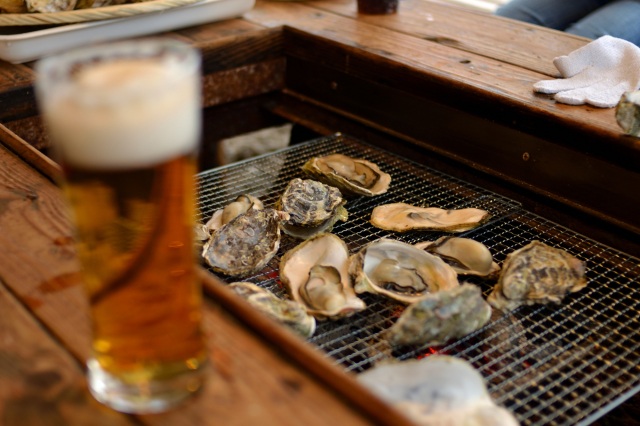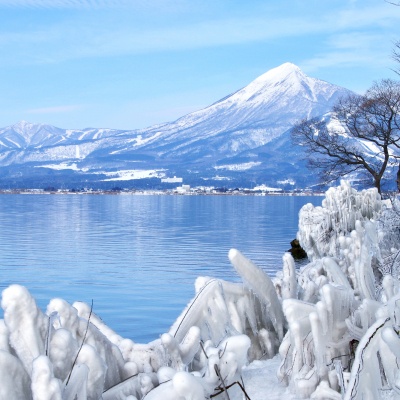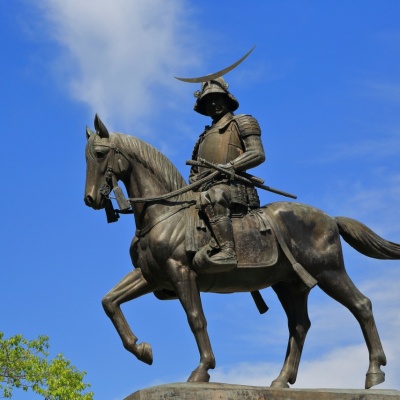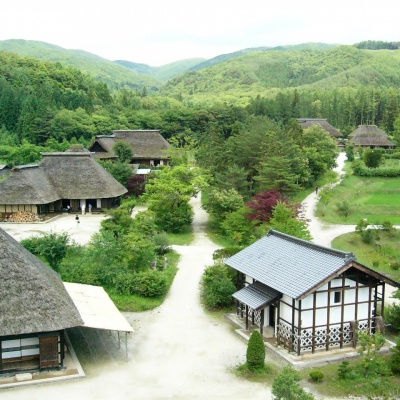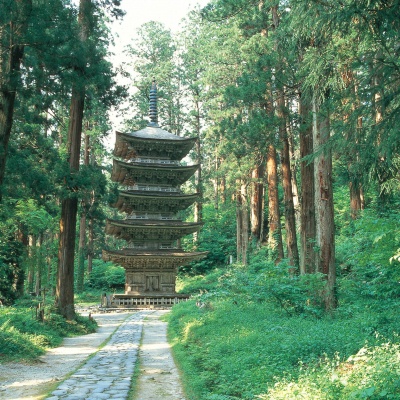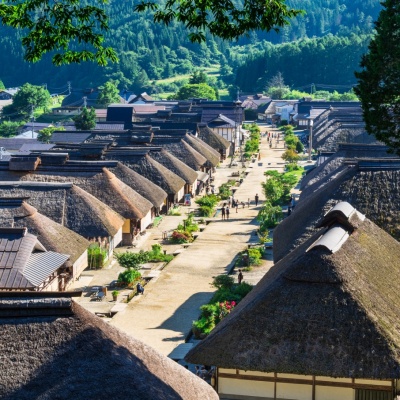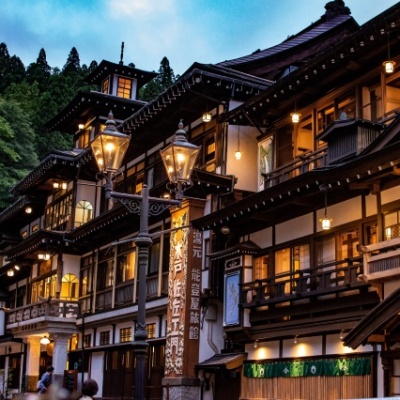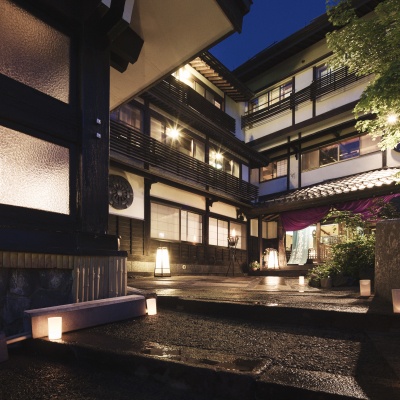Historic tour of Sendai, Matsushima and Aizu (2 days)
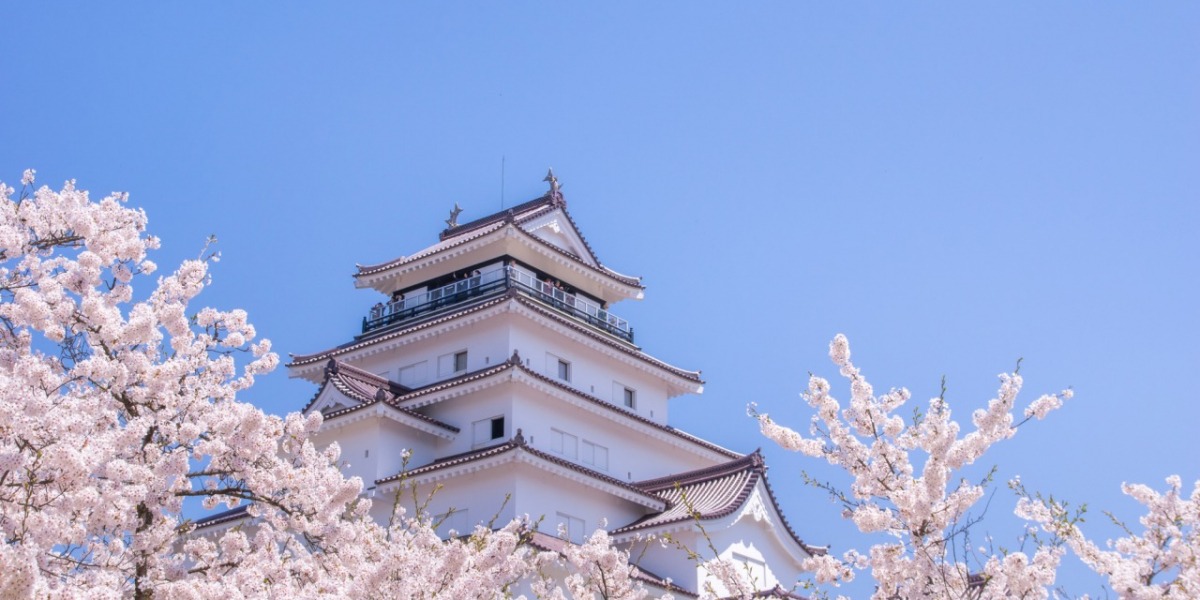
Historic tour of Sendai, Matsushima and Aizu (2 days)
START
Day1
Zuiganji Temple
A temple filled with the passion and aesthetics of the celebrated feudal lord Masamune
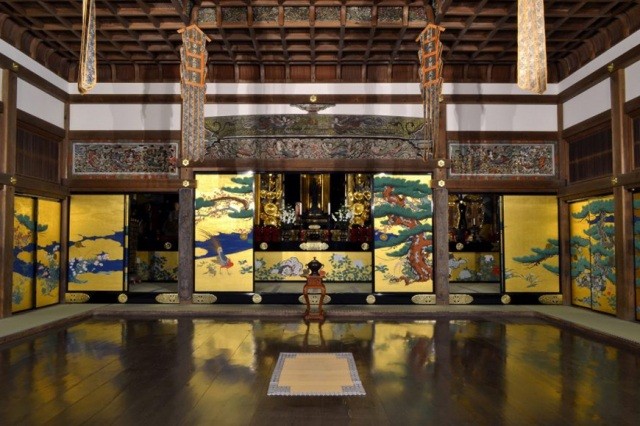
Zuiganji is the family temple of Masamune Date, a famous feudal lord of the Age of Civil Wars of the 15th and 16th centuries. The temple was originally founded in 828. After deterioration through the civil war period it was restored by Masamune Date and his aesthetic styling can be seen throughout the buildings.
The main hall and Kuri (the Zen kitchen) are designated national treasures. Inside the main hall the brilliant paintings on the sliding doors are a must see. The graceful Ume (Japanese plum) blossoms surrounding the main hall are exhilarating in spring. Visitors can also see Masamune’s aesthetics in the arabesque-pattern engravings in the Kuri.
Zuiganji offers much to see including officially designated Important Cultural Properties (Onarimon Gate, Nakamon Gate and Taiko-bei Wall), and a series of caves used for memorial services including the rock cave known as Hosshinkutsu.
The treasure house Seido-den exhibits paintings and tea ceremony items connected with the Date families along with the original paintings of the main hall’s sliding doors.
Zuiganji is one of the four temples of the Shiji Kairo Pilgrimage trail along with Chusonji and Motsuji in Hiraizumi, Iwate and Risshakuji in the mountains of Yamagata.
The renowned Entsuin temple is in the same complex and there are a number of restaurants and souvenir shops where visitors can take a break. Godaido Hall, the temple founded by Masamune previous to Zuiganji, is located nearby on the shore of Matsushima Bay.
After enjoying the breath-taking views across Matsushima Bay – known as one of Japan’s top three scenic sights – these temples are the perfect place to calm the mind and feel the spirit of the feudal Date family.
A thematic journey in the Tohoku region:Okuno Hosomichi・The History of Michinoku
The main hall and Kuri (the Zen kitchen) are designated national treasures. Inside the main hall the brilliant paintings on the sliding doors are a must see. The graceful Ume (Japanese plum) blossoms surrounding the main hall are exhilarating in spring. Visitors can also see Masamune’s aesthetics in the arabesque-pattern engravings in the Kuri.
Zuiganji offers much to see including officially designated Important Cultural Properties (Onarimon Gate, Nakamon Gate and Taiko-bei Wall), and a series of caves used for memorial services including the rock cave known as Hosshinkutsu.
The treasure house Seido-den exhibits paintings and tea ceremony items connected with the Date families along with the original paintings of the main hall’s sliding doors.
Zuiganji is one of the four temples of the Shiji Kairo Pilgrimage trail along with Chusonji and Motsuji in Hiraizumi, Iwate and Risshakuji in the mountains of Yamagata.
The renowned Entsuin temple is in the same complex and there are a number of restaurants and souvenir shops where visitors can take a break. Godaido Hall, the temple founded by Masamune previous to Zuiganji, is located nearby on the shore of Matsushima Bay.
After enjoying the breath-taking views across Matsushima Bay – known as one of Japan’s top three scenic sights – these temples are the perfect place to calm the mind and feel the spirit of the feudal Date family.
A thematic journey in the Tohoku region:Okuno Hosomichi・The History of Michinoku
Godaido Temple
The symbol of Matsushima - this temple sits on its own small island with a connecting vermilion-lacquered bridge
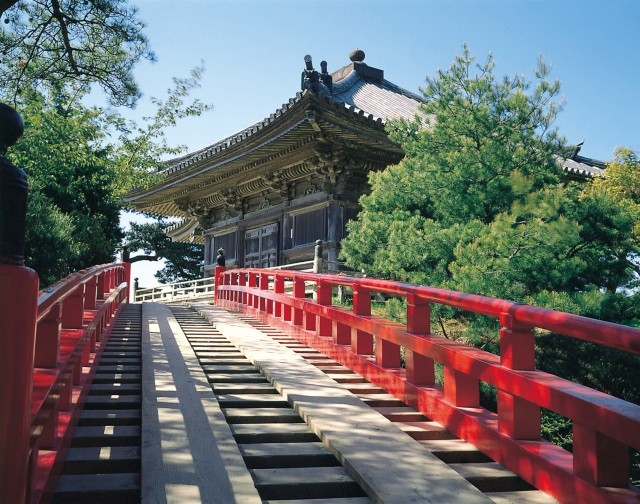
Perched on a small island jutting out into Matsushima Bay with a vermilion-lacquered bridge connecting it to the mainland, Godaido Temple is the traditional symbol of Matsushima and a scenic location from which to view the bay.
The small temple was originally founded as Bishamondo by the famous general Tamuramaro Sakanoue in 807 and took its name Godaido when the priest Ennin installed images of the Five Wisdom Kings in 828. The temple opens its doors to the public for the viewing of these images only once every 33 years.
The present temple is the one founded by the celebrated feudal lord Masamune Date. The meticulous carvings of the 12 signs of the zodiac under the eaves reflect the artistic style of the Azuchi-Momoyama period which flourished between late 16th and early 17th centuries. Godaido Temple is designated an Important Cultural Property as Tohoku’s oldest building in the style of the Azuchi-Momoyama period.
When walking across Sukashi Bridge connecting the mainland and Godaido Temple visitors can observe the water below through the wide gaps in the bridge floor. These gaps were intentionally left so that visitors would brace themselves before praying in the temple. The original bridge was in the form of a ladder, two horizontal boards were later added to allow an easier walk.
Legend has it that one night the image of Bishamonten (Vaisravana) that was enshrined by Tamuramaro Sakanoue at Bishamondo flew away to an offshore island when the priest Ennin installed the images of the Five Wisdom Kings at Bishamondo as a part of Enpukuji (Zuiganji), after which the island took its name and became Bishamon Island.
Visitors enjoy the spectacular view of the floating islands of Matsushima Bay while reflecting on this legend. Visiting the twin temples of Zuiganji and Godaigo makes for a magical Matsushima experience!
The small temple was originally founded as Bishamondo by the famous general Tamuramaro Sakanoue in 807 and took its name Godaido when the priest Ennin installed images of the Five Wisdom Kings in 828. The temple opens its doors to the public for the viewing of these images only once every 33 years.
The present temple is the one founded by the celebrated feudal lord Masamune Date. The meticulous carvings of the 12 signs of the zodiac under the eaves reflect the artistic style of the Azuchi-Momoyama period which flourished between late 16th and early 17th centuries. Godaido Temple is designated an Important Cultural Property as Tohoku’s oldest building in the style of the Azuchi-Momoyama period.
When walking across Sukashi Bridge connecting the mainland and Godaido Temple visitors can observe the water below through the wide gaps in the bridge floor. These gaps were intentionally left so that visitors would brace themselves before praying in the temple. The original bridge was in the form of a ladder, two horizontal boards were later added to allow an easier walk.
Legend has it that one night the image of Bishamonten (Vaisravana) that was enshrined by Tamuramaro Sakanoue at Bishamondo flew away to an offshore island when the priest Ennin installed the images of the Five Wisdom Kings at Bishamondo as a part of Enpukuji (Zuiganji), after which the island took its name and became Bishamon Island.
Visitors enjoy the spectacular view of the floating islands of Matsushima Bay while reflecting on this legend. Visiting the twin temples of Zuiganji and Godaigo makes for a magical Matsushima experience!
Lunch in Matsushima (enjoy the fresh seafood of the season)
Zuihoden
The resting place of Date Masamune
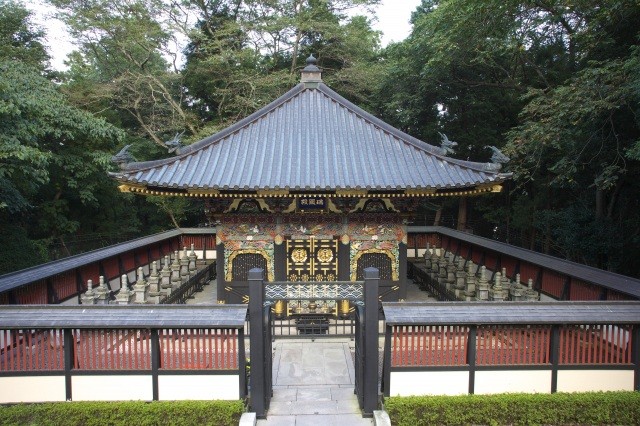
Zuihoden is the mausoleum of Date Masamune, the founder of Sendai and most powerful daimyo (feudal lord) of the Tohoku region. Constructed in 1637 and designated as a National Treasure in 1931, it was destroyed by a fire during the second world war; the present structure was built in 1979 and reconstructed in its original Momoyama architectural style. There is a second and third generation mausoleum on the site, as well as a museum displaying excavation materials.
*Please check the official website for the latest information.
*Please check the official website for the latest information.
Iizaka Onsen
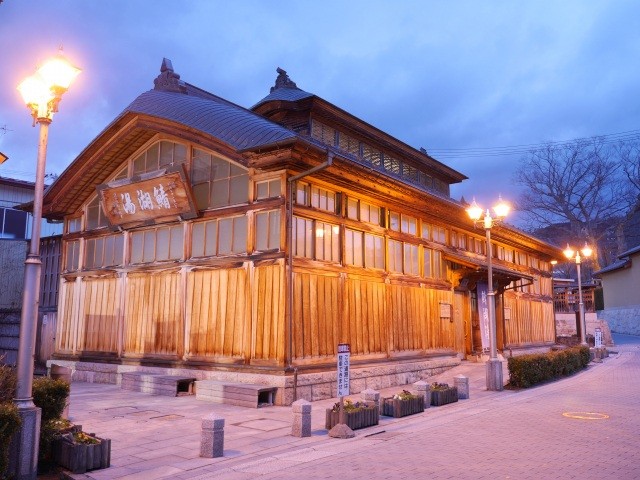
Iizaka Onsen, one of the most famous hot spring resorts in Tohoku, has been visited by writers such as Matsuo Basho, Masaoka Shiki, and Yosano Akiko.If you take the Iizaka train from Fukushima Station, you will arrive at Iizaka Onsen Station, the last stop, in about 25 minutes.Hotels and inns are built around the Surikami River and its tributaries, and visitors can fully enjoy the atmosphere of a traditional hot spring.Walking along the chanko-chanko (a local dialect word for stone steps leading up a slope), you will find public bathhouses and delicious restaurants here and there, and you will always discover something new no matter how many times you visit.The chic conversation with the locals will make your trip even more fascinating.Enjoy your trip in any way you like. Welcome to Iizaka Onsen!The water is hot, so be careful!Public bathhouses have long been used as indoor baths by Iizaka residents.It is fun to visit several bathhouses and enjoy the atmosphere of the town of hot spring and the town of slope.Iizaka Onsen's mild, mild water is not peculiar and does not cool down easily, leaving your skin smooth and silky.
【Kyu Horikiri-tei】 Free admissionIn the center of the hot spring resort area, you will find the “Kyu Horikiri-tei” (an old house of a wealthy farmer and merchant that has been in existence since the Edo period), which is a nationally registered tangible cultural property.Buildings of high historical value still exist, including the oldest earthen storehouse in the prefecture, “Jyukken-gura,” built in 1775, and the main building, which was rebuilt in 1881 after it was destroyed by fire.The “footbath and handbath” with hot spring water from the Iizaka hot spring will fill your heart and soul as you enjoy these precious cultural assets.
【Hanamomo-no-Sato 】 Flowering season: Early to late AprilAbout 300 flowering peach trees of 40 varieties, collected from all over the world, are planted on an 80-area site.From the beginning to the end of April, visitors can enjoy the colorful blooms of this peachy paradise.
【Ioji Temple】 Both Ohi and Tachi are decorated with Kaminobori in MayThis is the family temple of Sato Tsugunobu and Tadanobu, who served Minamoto no Yoshitsune and played an active role in the Battle of Genpei.Yoshitsune is said to have stopped by the temple when he fled to Hiraizumi in Oshu, and Matsuo Basho visited the temple and composed a haiku in memory of the two men.
【Lake Moniwakko】 was created by the Surikamigawa Dam.Around Lake Moniwakko, you can enjoy the scenery of the four seasons, and there are many places of interest such as “Nametaki” and “Renge Falls.Kayaking at the source of “Fukushima's water,” which has won the Monde Selection gold medal for three consecutive years, is a relaxing experience for both body and soul.
【Local Gourmet】Disc dumplings, squid carrots, Iizaka ramen, radium eggs, Iizaka granola, etc.
【Kyu Horikiri-tei】 Free admissionIn the center of the hot spring resort area, you will find the “Kyu Horikiri-tei” (an old house of a wealthy farmer and merchant that has been in existence since the Edo period), which is a nationally registered tangible cultural property.Buildings of high historical value still exist, including the oldest earthen storehouse in the prefecture, “Jyukken-gura,” built in 1775, and the main building, which was rebuilt in 1881 after it was destroyed by fire.The “footbath and handbath” with hot spring water from the Iizaka hot spring will fill your heart and soul as you enjoy these precious cultural assets.
【Hanamomo-no-Sato 】 Flowering season: Early to late AprilAbout 300 flowering peach trees of 40 varieties, collected from all over the world, are planted on an 80-area site.From the beginning to the end of April, visitors can enjoy the colorful blooms of this peachy paradise.
【Ioji Temple】 Both Ohi and Tachi are decorated with Kaminobori in MayThis is the family temple of Sato Tsugunobu and Tadanobu, who served Minamoto no Yoshitsune and played an active role in the Battle of Genpei.Yoshitsune is said to have stopped by the temple when he fled to Hiraizumi in Oshu, and Matsuo Basho visited the temple and composed a haiku in memory of the two men.
【Lake Moniwakko】 was created by the Surikamigawa Dam.Around Lake Moniwakko, you can enjoy the scenery of the four seasons, and there are many places of interest such as “Nametaki” and “Renge Falls.Kayaking at the source of “Fukushima's water,” which has won the Monde Selection gold medal for three consecutive years, is a relaxing experience for both body and soul.
【Local Gourmet】Disc dumplings, squid carrots, Iizaka ramen, radium eggs, Iizaka granola, etc.
Day2
Aizuwakamatsu Nanukamachi-dori Street
Enjoy a stroll around this nostalgic town
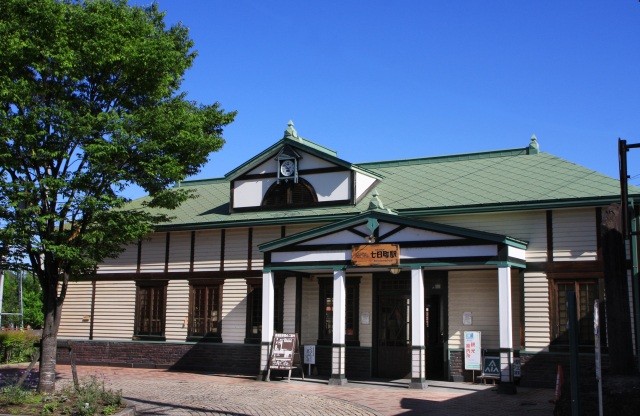
From JR Nanukamachi station, the 700m Nanukamachi-dori Street leads to Noguchi Hideyo Seishun-dori. The street is lined with early 20th century architecture.
Visitors can travel back in time along this street lined with shops offering traditional arts and crafts such as hand-decorated candles, Aizu lacquerware and Aizu cotton. The town rewards a lingering stroll while enjoying traditional architectural designs pleasing to the eye and sampling some of the tasty treats on offer including varieties of Japanese sweets and a number of sake breweries. A retro-style sightseeing bus “Haikara-san” offers nostalgic rides through town.
The local streets are home not only to exquisite shops but also to a number of locations related to the Shinsengumi, a special police force set up to protect Shogun in the late Edo period. They are also not far from Tsurugajo Castle, which comes alive throughout the seasons.
The Eki Café at JR Nanukamachi station functions as an information centre. Visitors can also purchase local products, arts and crafts from 17 towns and villages of the Aizu region. This cozy café is a lovely place to unwind!
Visitors can travel back in time along this street lined with shops offering traditional arts and crafts such as hand-decorated candles, Aizu lacquerware and Aizu cotton. The town rewards a lingering stroll while enjoying traditional architectural designs pleasing to the eye and sampling some of the tasty treats on offer including varieties of Japanese sweets and a number of sake breweries. A retro-style sightseeing bus “Haikara-san” offers nostalgic rides through town.
The local streets are home not only to exquisite shops but also to a number of locations related to the Shinsengumi, a special police force set up to protect Shogun in the late Edo period. They are also not far from Tsurugajo Castle, which comes alive throughout the seasons.
The Eki Café at JR Nanukamachi station functions as an information centre. Visitors can also purchase local products, arts and crafts from 17 towns and villages of the Aizu region. This cozy café is a lovely place to unwind!
Lunch in Aizu-Wakamatsu city
Aizu Sauce Katsu-don
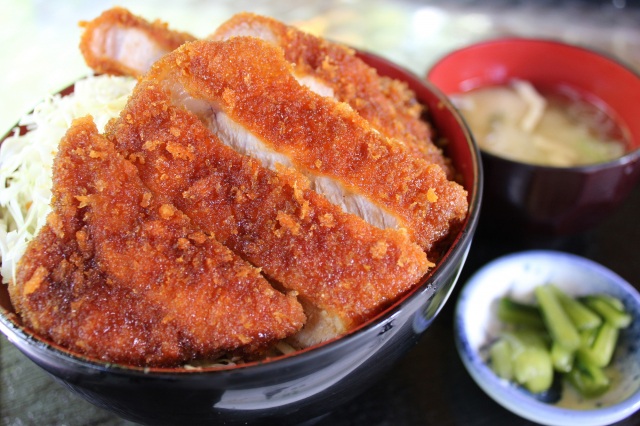
Katsu-don is a nationally popular dish of a deep-fried pork cutlet (Tonkatsu) simmered in a dashi stock with onions and eggs and served over a bowl of rice. Aizu Sauce Katsu-don, a local specialty of the Aizu region dating back to the Taisho period, has a unique recipe. A bowl of rice is topped with shredded cabbage and Tonkatsu dipped in a special thick sauce. The crispy Tonkatsu and crunchy cabbage perfectly match the sauce-drizzled rice, satisfying both appetite and mind!
Search Restaurants
Search Restaurants
Tsuruga Castle
Japan’s only castle with elegant red tiled roofs
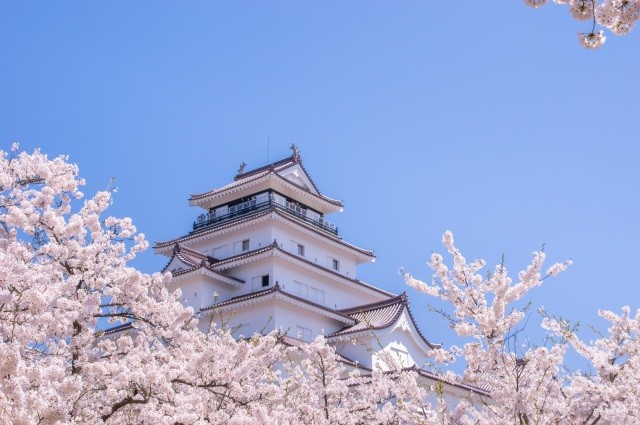
Tsuruga Castle, also known as Aizu Castle or Aizuwakamatsu Castle, is famed as an impregnable fortress that withstood a month-long siege by the newly formed government during the Boshin war in 1868.
The castle has undergone additional repairs since being reconstructed in 1965. Reroofing work was completed in 2011 to reproduce the look of the 17th century castle. Selected as one of Japan’s most famous 100 castles, it is the only existing castle with red tiled roofs in Japan. The stone walls of the castle tower survived the devastating 1611 earthquake and today stand in their original form.
The castle keep is now open as a museum and visitors can enjoy a panoramic view of the city of Aizuwakamatsu from the top floor. After exploring the castle, the tearoom “Rinkaku” in the Tsuruga Castle Park, built by the tea master Sen no Rikyu’s son-in-law, is the perfect place to enjoy a cup of tea in the castle’s traditional garden.
Tsuruga Castle Park is famous for its thousand cherry blossom trees illuminated at night. The surrounding trees are also illuminated in autumn to show off the vividly changing colours of their leaves. Meanwhile the castle fills with visitors during the “Aizue Candle Festival” each winter. The view of the snow-covered castle illuminated by traditional hand-decorated candles is unforgettable!
A thematic journey in the Tohoku region:Castles・Samurai
The castle has undergone additional repairs since being reconstructed in 1965. Reroofing work was completed in 2011 to reproduce the look of the 17th century castle. Selected as one of Japan’s most famous 100 castles, it is the only existing castle with red tiled roofs in Japan. The stone walls of the castle tower survived the devastating 1611 earthquake and today stand in their original form.
The castle keep is now open as a museum and visitors can enjoy a panoramic view of the city of Aizuwakamatsu from the top floor. After exploring the castle, the tearoom “Rinkaku” in the Tsuruga Castle Park, built by the tea master Sen no Rikyu’s son-in-law, is the perfect place to enjoy a cup of tea in the castle’s traditional garden.
Tsuruga Castle Park is famous for its thousand cherry blossom trees illuminated at night. The surrounding trees are also illuminated in autumn to show off the vividly changing colours of their leaves. Meanwhile the castle fills with visitors during the “Aizue Candle Festival” each winter. The view of the snow-covered castle illuminated by traditional hand-decorated candles is unforgettable!
A thematic journey in the Tohoku region:Castles・Samurai
Aizu Bukeyashiki (Samurai Residence)
Discover Aizu’s history and culture at this museum complex
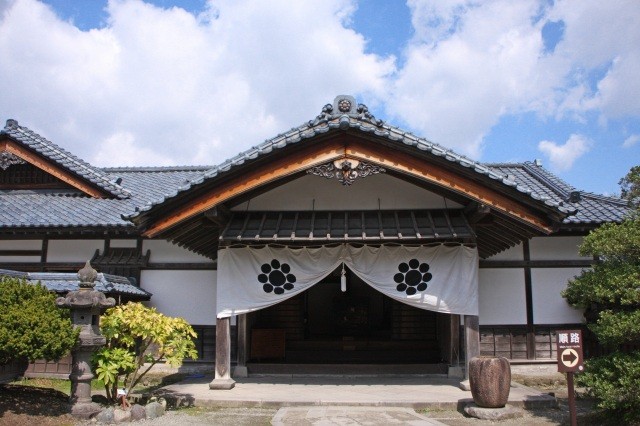
Aizu Bukeyashiki is a historical site of reconstructed samurai residences of the Edo period. The preserved buildings include the residences of the former chief councillor Tanomo Saigo, a magistrate’s office and a replica of the tearoom “Rinkaku” of Tsuruga Castle.
Visitors can learn about the samurai’s lifestyle and the Boshin war at the museum on site. The residence of Tanoma Saigo is open to public from mid-December to early April.
A variety of Aizu’s traditional cultural experiences are available for visitors to enjoy including painting the local lucky charms “Akabeko” (red cattle), glass engraving, and having your picture taken dressed as a villager of the Edo period.
There is a restaurant serving regional dishes on site along with a shop offering a wide range of traditional handicrafts and local produce, a great place to find some souvenirs to take home!
Visitors can learn about the samurai’s lifestyle and the Boshin war at the museum on site. The residence of Tanoma Saigo is open to public from mid-December to early April.
A variety of Aizu’s traditional cultural experiences are available for visitors to enjoy including painting the local lucky charms “Akabeko” (red cattle), glass engraving, and having your picture taken dressed as a villager of the Edo period.
There is a restaurant serving regional dishes on site along with a shop offering a wide range of traditional handicrafts and local produce, a great place to find some souvenirs to take home!
Sazaedo
Experience the wonderland of this double-helix wooden structure – the only one of its kind!
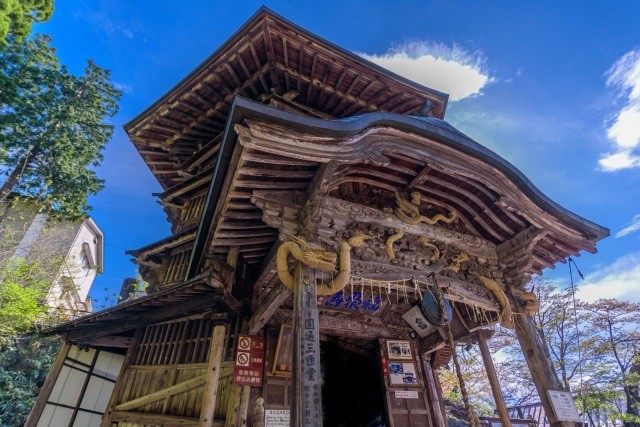
Sazae-do is a three-storied, hexagonal pagoda with the look of an optical illusion. Officially called “Entsu Sansodo”, the temple is known by the nickname “Sazae-do” as its shape resembles a turban shell. The double-helix wooden structure is the only one of its kind in the world and has been designated an Important Cultural Property.
Go inside and walk up the winding slope while observing the curved windows. Thanks to its one-way path you never have to pass anyone on your way up or down. Rumours abound about the construction of this unique structure. According to one Sazae-do was based on the design of Leonard da Vinci’s Chateau de Chambord. Another says the temple’s head priest was inspired by a revelation from heaven. Experience the wonder of the one-way spiral path within this strangely distorted interior space!
Sazae-do was once part of a pilgrimage trail with 33 Kannon statues lining the slope up to the structure. Pilgrims came here as an alternative to the Saigoku Kannon Pilgrimage and today the ceiling of Sazae-do is still covered with stickers from people who accomplished the pilgrimage here.
The building is part of a shrine complex at the base of Mount Iimori. The “Uga Shindo”, 19 statues worshipping the famous Byakkotai (a group of young samurai), is located nearby.
Go inside and walk up the winding slope while observing the curved windows. Thanks to its one-way path you never have to pass anyone on your way up or down. Rumours abound about the construction of this unique structure. According to one Sazae-do was based on the design of Leonard da Vinci’s Chateau de Chambord. Another says the temple’s head priest was inspired by a revelation from heaven. Experience the wonder of the one-way spiral path within this strangely distorted interior space!
Sazae-do was once part of a pilgrimage trail with 33 Kannon statues lining the slope up to the structure. Pilgrims came here as an alternative to the Saigoku Kannon Pilgrimage and today the ceiling of Sazae-do is still covered with stickers from people who accomplished the pilgrimage here.
The building is part of a shrine complex at the base of Mount Iimori. The “Uga Shindo”, 19 statues worshipping the famous Byakkotai (a group of young samurai), is located nearby.
Mount Iimori
Reflect on the tragedy of these young worriers
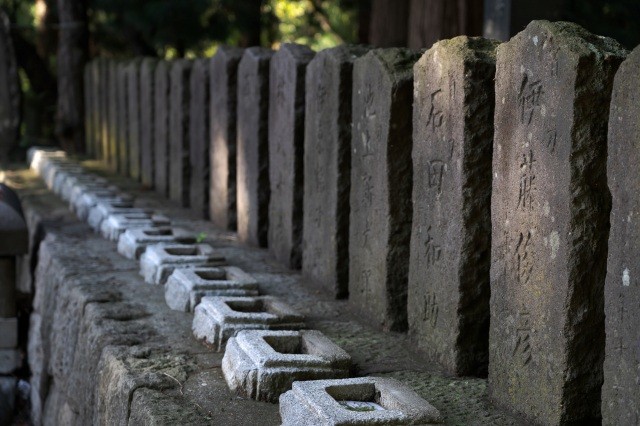
Located 314 metres above sea level, Mount Iimori overlooks the former castle town of Aizuwakamatsu. You can reach the top of the mountain via a path of 183 steps or taking the convenient travelator.
The graves of the 19 members of Byakkotai (“White Tiger Force”) at Mount Iimori commemorate the tragedy of the Aizu War, a local battle of the Boshin War in 1868. The Byakkotai was made up of teenage warriors who fought for the local Aizu feudal domain. When they saw Tsuruga Castle surrounded by clouds of smoke they believed the castle was in flames and committed suicide for their master. Nowadays many people still come to memorial services for these young warriors. Visitors can see the castle exactly as it was when the Byakkotai observed it from this tragic spot. The grave of the sole surviving member is located nearby.
There are monuments from Italy and Germany honouring the Byakkotai for their loyalty. Visitors can also see the canal cave through which the Byakkotai retreated from the battlefield of Tonoguchihara.
The Byakkotai Memorial Museum, the Byakkotai Museum of History and an Important Cultural Property, Takizawa Honjin are in the neighbourhood. Mount Iimori is also home to the Important Cultural Property of Sazae-do which attracts many visitors throughout the year.
Located on the mountainside, Iimori Bunten is a convenient place to take a break and have lunch while enjoying wonderful views of the city of Aizuwakamatsu.
The graves of the 19 members of Byakkotai (“White Tiger Force”) at Mount Iimori commemorate the tragedy of the Aizu War, a local battle of the Boshin War in 1868. The Byakkotai was made up of teenage warriors who fought for the local Aizu feudal domain. When they saw Tsuruga Castle surrounded by clouds of smoke they believed the castle was in flames and committed suicide for their master. Nowadays many people still come to memorial services for these young warriors. Visitors can see the castle exactly as it was when the Byakkotai observed it from this tragic spot. The grave of the sole surviving member is located nearby.
There are monuments from Italy and Germany honouring the Byakkotai for their loyalty. Visitors can also see the canal cave through which the Byakkotai retreated from the battlefield of Tonoguchihara.
The Byakkotai Memorial Museum, the Byakkotai Museum of History and an Important Cultural Property, Takizawa Honjin are in the neighbourhood. Mount Iimori is also home to the Important Cultural Property of Sazae-do which attracts many visitors throughout the year.
Located on the mountainside, Iimori Bunten is a convenient place to take a break and have lunch while enjoying wonderful views of the city of Aizuwakamatsu.
GOAL
